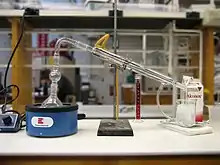
Within the sciences residue is a complex concept with multiple meanings. The general definition for residue is a product left behind after a chemical reaction, and can refer to the main product, a by-product, or a combination of both.
In chemistry, residue is whatever remains or acts as a contaminant after a given class of events. Residue may be the material remaining after a process of preparation, separation, or purification, such as distillation, evaporation, or filtration. It may also denote the undesired by-products of a chemical reaction.
Residues as an undesired by-product are a concern in agricultural and food industries.
Food safety
Toxic chemical residues, wastes or contamination from other processes, are a concern in food safety. The most common food residues originate from pesticides, veterinary drugs, and industrial chemicals.[1] For example, the U.S. Food and Drug Administration (FDA) and the Canadian Food Inspection Agency (CFIA) have guidelines for detecting chemical residues that are possibly dangerous to consume.[2][3] In the U.S., the FDA is responsible for setting guidelines while other organizations enforce them.
Environmental concerns
Similar to the food industry, in environmental sciences residue also refers to chemical contaminants. Residues in the environment are often the result of industrial processes, such as escaped chemicals from mining processing, fuel leaks during industrial transportation, trace amounts of radioactive material, and excess pesticides that enter the soil.[4]

Characteristic units within a molecule
Residue may refer to an atom or a group of atoms that form part of a molecule, such as a methyl group.
Biochemistry
In biochemistry and molecular biology, a residue refers to a specific monomer within the polymeric chain of a polysaccharide, protein or nucleic acid. In proteins, the amino acid monomer is a unique residue with unique properties.[5] A residue's properties will influence interactions with other residues and the overall chemical properties of the protein it resides in. One might say, "This protein consists of 118 amino acid residues" or "The histidine residue is considered to be basic because it contains an imidazole ring." Note that a residue is different from a moiety, which, in the above example would be constituted by the imidazole ring or the imidazole moiety.
References
- ↑ "Chemical Residues and Contaminants". Food Safety and Inspection Service U.S. Department of Agriculture. July 28, 2023.
- ↑ "Drug & Chemical Residues Methods". U.S. Food and Drug Administration.
- ↑ "Chemical Residues / Microbiology - Food". Canadian Food Inspection Agency.
- ↑ Tudi, Muyesaier; Daniel Ruan, Huada; Wang, Li; Lyu, Jia; Sadler, Ross; Connell, Des; Chu, Cordia; Phung, Dung Tri (February 2021). "Agriculture Development, Pesticide Application and Its Impact on the Environment". International Journal of Environmental Research and Public Health. 18 (3): 1112. doi:10.3390/ijerph18031112. ISSN 1661-7827. PMC 7908628. PMID 33513796.
- ↑ deGruyter, Justine N.; Malins, Lara R.; Baran, Phil S. (2017-08-01). "Residue-Specific Peptide Modification: A Chemist's Guide". Biochemistry. 56 (30): 3863–3873. doi:10.1021/acs.biochem.7b00536. ISSN 0006-2960. PMC 5792174. PMID 28653834.